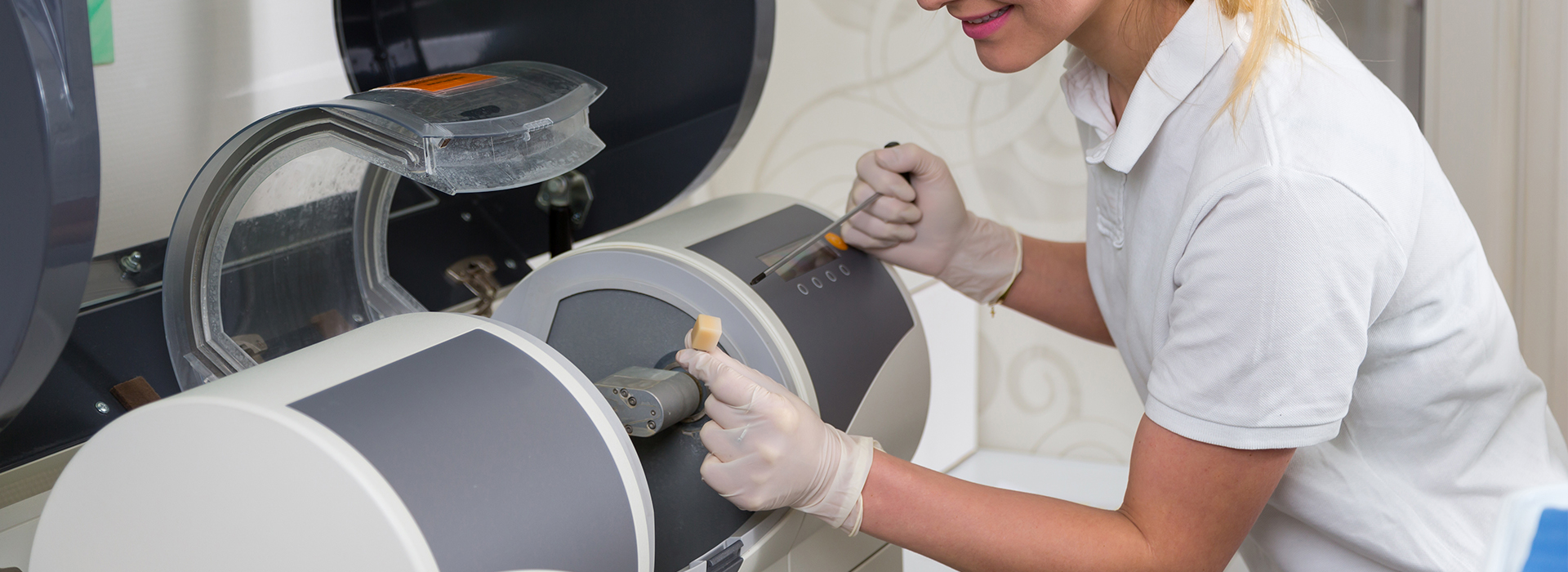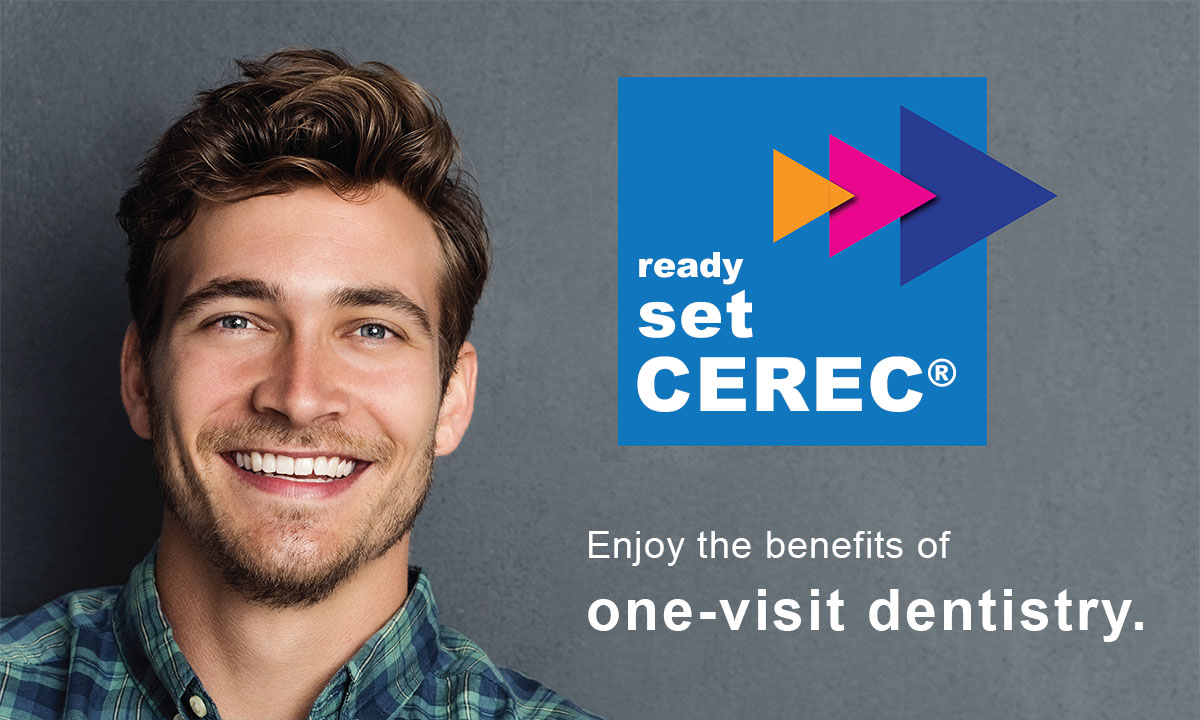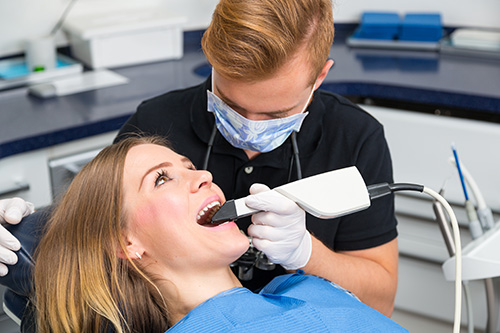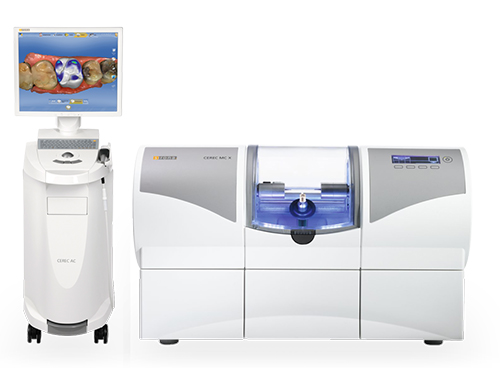Hablamos español!
Hablamos español!


CEREC® transforms how restorations are delivered by completing crowns, inlays, and onlays in a single appointment. Rather than returning for multiple visits or wearing a temporary restoration, most patients experience fewer interruptions to their schedule and a more comfortable workflow from start to finish. The single-visit approach reduces the number of anesthetic events and shortens the overall treatment timeline without sacrificing quality.
This method is particularly appealing for people with busy lives or travel constraints — the digital workflow replaces traditional impression trays and temporary crowns with a streamlined, predictable process. Because the restoration is designed and produced chairside, clinicians can refine shape, fit, and color immediately, improving the final outcome and patient satisfaction.
Beyond convenience, the single-visit model supports better continuity of care. When the clinician controls every step of the design and fabrication, there’s greater consistency between planning and placement. That hands-on control helps produce restorations that integrate smoothly with your bite and neighboring teeth.

The process begins with a careful clinical exam and preparation of the tooth, followed by a quick, non-invasive digital scan. Instead of traditional putty impressions, the dentist uses an intraoral scanner to capture detailed, three-dimensional images of the prepared tooth and the surrounding dentition. The scan is fast, accurate, and comfortable for most patients, eliminating the gag reflex and messy materials often associated with conventional impressions.
Those 3D images are immediately available for inspection and adjustment on a chairside computer. The dentist can manipulate the model, refine margins, and design occlusion and contacts in real time, giving you a chance to review shape and shade before the restoration is produced. This interactive step helps ensure the final piece meets both functional and cosmetic goals.
Once the design is approved, the data is sent to an on-site milling unit. While you wait, the machine sculpts the restoration from a solid block of high-quality ceramic. The speed of fabrication means that what once took weeks in a laboratory can now be completed in an hour or two, allowing same-day placement and final adjustments during the visit.

The heart of the system is computer-aided design and manufacturing (CAD/CAM). After scanning, advanced software generates a precise virtual model that guides the milling process. The milling unit carves the restoration from a ceramic block chosen for strength and lifelike optical properties. These ceramics exhibit translucency and shading that mimic natural enamel, which helps the restoration blend seamlessly with adjacent teeth.
Finishing steps include staining, glazing, and polishing to refine shade and surface texture. The dentist checks fit and occlusion, making micro-adjustments to ensure comfort and function. Because the restoration is fabricated from a single block, it doesn’t rely on layered bonding techniques that can sometimes introduce weak points; the result is often a cohesive, durable piece that performs well under normal chewing forces.
Bonding the restoration securely to the prepared tooth is the final clinical step. Modern adhesive techniques create a stable interface between ceramic and tooth structure, helping preserve remaining enamel and minimize future complications. The combined precision of digital planning and careful adhesive protocols contributes to long-term success.

Ceramic restorations produced with this technology are designed to look like natural teeth while withstanding everyday function. High-quality ceramics can resist wear and maintain color stability over time when maintained with good oral hygiene. The translucency and polish achievable with these materials often produce results that are difficult to distinguish from natural enamel, making them suitable for visible front and back teeth.
Longevity depends on several factors — occlusal forces, oral hygiene, and regular dental maintenance all play a role — but properly designed and bonded ceramic restorations are a durable option for many patients. Because the restoration is fabricated and adjusted in one visit, there’s also less risk of fit issues that sometimes occur when multiple fabrication steps are separated by time.
Maintenance is straightforward: continue routine brushing and flossing and attend periodic professional exams so your dentist can monitor the restoration and surrounding structures. In most cases, routine care is all that’s needed to preserve both function and appearance for years to come.
Candidacy for a same-day ceramic restoration depends on the condition of the tooth, overall oral health, and the complexity of the case. Small to moderate restorations such as inlays, onlays, and single crowns are often ideal for this workflow. Complex cases involving multiple connected units, extensive bite reconstruction, or certain implant prosthetics may still require laboratory collaboration to achieve the best outcome.
During a consultation, your dentist will evaluate factors like tooth structure, bite relationships, and aesthetic goals to determine whether a chairside restoration is appropriate. The advantage of an in-person evaluation is that it allows a personalized treatment plan that considers both the long-term health of your mouth and your everyday lifestyle needs.
For patients who want to reduce the number of visits without compromising quality, this digital, chairside approach can be an excellent choice. It offers predictability, faster turnaround, and the chance to review design decisions with your clinician before fabrication begins.
Wrap-up: CEREC®-style digital restorations combine modern scanning, software-driven design, and chairside milling to deliver natural-looking ceramic work in a single visit. If you’d like to learn whether this approach is a good match for your smile, contact Everything Smiles for more information and to schedule a consultation.
Today, there's no need to merely imagine how nice it would be to have a dental crown fabricated in a single visit. With CEREC technology and advanced systems of care, multiple trips to the dentist are a thing of the past! Now, one appointment is all it takes for our skilled and experienced dentist to design, fabricate, and place a naturally beautiful and long-lasting same-day crown. And, best of all, unlike conventional methods of care, you won't have to endure messy dental impressions, wear a temporary crown, or wait weeks for your permanent restoration to come back from the laboratory.
Offering a level of precision and comfort that exceeds conventional methods of care, CEREC technology is nothing short of amazing! Advanced CAD/CAM technology, which stands for computer-aided design and computer-aided manufacturing, enables our dentist to translate images from an optically scan tooth into a 3D virtual model upon which a custom crown can be digitally designed. Once this step is done, the detailed specs are then wirelessly transmitted to a chairside 3D milling machine to fabricate your new ceramic crown while you wait!
With conventional methods of care, a dental crown can take two to three visits to fabricate and place. However, thanks to the benefits of CEREC technology, we can prepare a tooth, then design, fabricate, and place your new crown, all while you wait.
With CEREC same-day crowns, there's none of the mess of conventional dental impressions, wearing dental temporaries, or waiting for the final crown to come back from the lab. Once the prepared tooth is optically scanned and the restoration digitally designed, your new crown can be milled from the highest quality of dental ceramics that very same visit.
CEREC same-day crowns and restorations are fabricated from the highest quality of dental ceramics. Because dental porcelain reflects light in much the same way as dental enamel, your new crown will look flawless, completely natural, and blend seamlessly with your smile.
A CEREC same-day crown offers much more than a convenient approach to getting a dental crown. It is also a high quality, naturally beautiful, extremely durable, and long-lasting dental restoration! The fact is, with proper oral hygiene and routine dental care your new crown will serve your smile well for many years to come.
CEREC® is a chairside CAD/CAM system that designs and mills ceramic dental restorations in a single visit. It enables creation of crowns, inlays and onlays from high-quality ceramic materials that are matched to your natural tooth shade. The process captures precise digital impressions and fabricates a final restoration while you wait, removing the need for multiple appointments.
Traditional crown workflows typically require physical impressions, a temporary crown and a separate laboratory to fabricate the final restoration. CEREC streamlines those steps into one appointment and reduces the potential for impression-related inaccuracies. This can improve patient comfort and convenience while maintaining strong aesthetic and functional results.
CEREC is commonly used to produce ceramic crowns, inlays and onlays that restore teeth damaged by decay or fracture. Many practitioners also use CEREC for single-tooth veneers and small cosmetic restorations when clinical conditions are appropriate. The system works with tooth-colored ceramic blocks that deliver lifelike translucency and shade matching.
The technology is versatile enough for a wide range of posterior and anterior restorations, provided there is sufficient tooth structure and appropriate occlusal conditions. The dentist evaluates each case to determine whether a chairside restoration is the best option for long-term function and appearance. When a case requires more complex laboratory techniques, the practice will recommend alternative workflows.
The CEREC process begins with an intraoral digital scan that captures a detailed three-dimensional image of the prepared tooth and surrounding dentition. That scan is imported into CAD software where the dentist designs the restoration with precise margins, contacts and occlusal anatomy. Once the design is approved, the file is sent to an on-site milling unit that fabricates the restoration from a solid ceramic block.
After milling, the restoration is finished, stained or glazed as needed to match adjacent teeth and then tried in for fit and aesthetics. The dentist can make final adjustments and cement or bond the restoration in the same appointment. This integrated digital workflow reduces sources of error and allows tight control over fit and contours.
Your appointment will begin with a clinical evaluation and any necessary local anesthesia to ensure comfort during tooth preparation. The dentist will prepare the tooth minimally, capture a digital impression with the intraoral scanner and review the computerized restoration design with you if desired. While the milling unit fabricates the restoration, the team will finish and shade the piece for a natural appearance.
Once the restoration is complete, the dentist will check fit, occlusion and aesthetics, make any minor adjustments and bond the permanent restoration in place. You will leave the same day with a fully finished crown, inlay or onlay and receive instructions for normal care and follow-up. The single-visit approach eliminates the need for a temporary restoration and a separate lab turnaround.
CEREC restorations are made from high-strength dental ceramics that offer excellent durability and natural aesthetics when properly designed and placed. Modern ceramic materials provide translucency and shade-matching that closely mimic natural tooth structure, resulting in pleasing cosmetic outcomes. Longevity depends on factors such as occlusal forces, oral hygiene and case selection, which your dentist will evaluate.
Because the design and milling occur in a controlled digital environment, CEREC restorations often achieve precise margins and contacts that support long-term performance. Proper bonding technique and occlusal adjustment are important contributors to durability, and your dentist will follow clinical protocols to optimize these factors. In cases that require specialized lab techniques, the dentist may still recommend a laboratory-fabricated option to meet specific clinical needs.
Good candidates for CEREC restorations include patients who need single-tooth crowns, inlays or onlays and prefer the convenience of a same-day solution. Candidates should have adequate remaining tooth structure and healthy surrounding gums to support a long-lasting restoration. A comprehensive clinical exam and digital imaging help determine whether the tooth is suitable for a chairside ceramic restoration.
Patients with complex occlusal problems, extensive bite wear or multi-unit restorative needs may require alternative treatment planning or laboratory-fabricated restorations. Your dentist will review your dental history, bite dynamics and cosmetic goals to recommend the most appropriate option. When CEREC is selected, it is because it offers the best balance of efficiency, fit and aesthetic outcome for that specific case.
While CEREC is highly versatile, it may not be the best choice for extremely complex cases such as multi-unit bridges, very large restorations or teeth with severe structural compromise that require specialized laboratory work. Certain esthetic cases that need layered ceramic artistry or custom staining may benefit from lab-fabricated restorations. Additionally, cases involving severe bite misalignment or parafunctional habits may need comprehensive occlusal management before a definitive restoration.
When the practice identifies clinical limitations, the dentist will discuss alternative options and explain why a lab-fabricated restoration or staged approach might provide a better long-term result. The decision is always based on preserving tooth structure, achieving proper function and delivering a predictable aesthetic outcome. Patient comfort, oral health and the clinical prognosis guide the final recommendation.
Caring for a CEREC restoration is similar to caring for a natural tooth: maintain regular brushing with a soft-bristled brush, daily flossing and routine dental checkups. Avoid using teeth as tools and minimize very hard or sticky foods that could place undue stress on any restoration. Good oral hygiene and routine professional cleanings help prevent decay at the restoration margins and support longevity.
If you have concerns about grinding or clenching, discuss them with your dentist, as a protective night guard may be recommended to reduce excessive forces. Report any unusual sensitivity, looseness or changes in your bite to the office promptly so adjustments can be made. Regular examinations allow the dentist to monitor restoration integrity and intervene early if needed.
A typical single-visit CEREC appointment usually ranges from about one to two hours depending on the scope of the procedure and any additional dental work required that day. This includes tooth preparation, digital scanning, CAD design, milling, finishing and final bonding of the restoration. Because the restoration is fabricated chairside, a temporary crown is generally not needed.
The exact appointment length varies by case complexity and the need for additional treatments such as root canal therapy or multiple restorations. Your dental team will explain the estimated time for your specific appointment when scheduling and provide preparation instructions to help the visit run smoothly. Patients appreciate leaving with a finished restoration instead of returning for multiple visits.
At Everything Smiles, the team combines clinical experience with proven digital protocols to ensure precise fit, proper occlusion and natural aesthetics for CEREC restorations. We use high-resolution intraoral scanning, careful CAD design and chairside finishing techniques to control margins, contacts and contour. Each restoration is evaluated clinically and adjusted as needed before final bonding to achieve optimal function and appearance.
Ongoing staff training and adherence to evidence-based bonding and finishing protocols support predictable outcomes and patient satisfaction. The practice schedules follow-up evaluations to confirm restoration performance and address any concerns early. By integrating advanced technology with clinical judgment, we aim to deliver durable, well-fitting ceramic restorations in a single visit.
